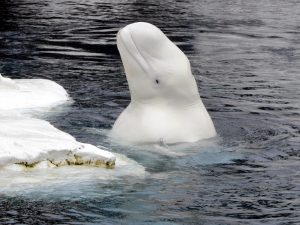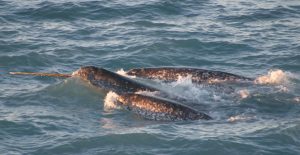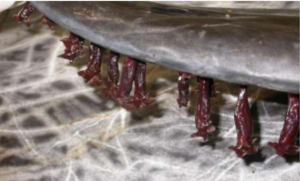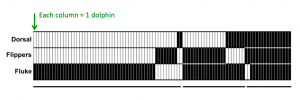Declining Sea Ice: Impacts on Arctic Cetaceans
By Rachael Ragen, SRC intern
Climate change has had a major impact on Arctic waters especially since it is reducing and thinning sea ice. Anthropogenic greenhouse gas emissions have caused the temperature to increase by about 0.2 ºC and almost all of this heat is absorbed by the ocean (Hoegh-Guldberg and Bruno 2010). This negatively impacts the sea ice, which can be problematic for marine mammals since many behaviors are tied to seasonal ice conditions. In March of 1979 there was 16.5 million km2 of Arctic sea ice, but this number decreased to 15.25 million km2 by March of 2009 (Hoegh-Guldberg and Bruno 2010). There are many other effects due to the warming of the oceans. Thermal expansion occurs due to the lowered density of the warmer water causing sea levels to rise. Currents are based upon changes in density due to different temperatures of the water. These may change due to increased warming. The ocean also absorbs excess carbon dioxide from the atmosphere causing ocean acidification, which can have major effects on phytoplankton and zooplankton. This causes problems throughout trophic levels since these organisms make up the basis of many food webs.
Since sea ice is an important factor in the Arctic marine habitat, many marine mammals will experience changes in all aspects of their lives. Some of the most susceptible to these problems are endemic Arctic species such as the narwhal, as they are highly specialized and have trouble altering their habitat. Many other species are thought to shift northward as the temperature continues to increase (Wassmann et al. 2010). The metabolic rates of species also change with temperature and move out of their ideal range (Hoegh-Guldberg and Bruno 2010). The prey of Arctic cetaceans will also be affected by these changes causing a decrease in food and shifts in the food web. The major factor in all of this is sea ice considering the seasonal changes of ice structures the habitat of the marine environment and influences the organisms as well as photosynthetic processes, which have a major impact on the prey of the bowhead whale.

Figure 1: Bowhead whale, (Source: https://upload.wikimedia.org/wikipedia/commons/8/87/A_bowhead_whale_breaches_off_the_coast_of_western_Sea_of_Okhotsk_by_Olga_Shpak%2C_Marine_Mammal_Council%2C_IEE_RAS.jpg)
The bowhead whale is extremely adapted to thick sea ice and can move through nearly solid sea ice cover (Laidre et al. 2008). They rely on copepods and euphasiids but also eat zooplankton as well as pelagic and epibenthic crustaceans (Laidre et al. 2008). Phytoplankton have a specifically timed bloom when the sea ice begins to melt. Zooplankton then feed on these phytoplankton, but if sea ice decreases the water column will be warmed earlier causing the phytoplankton may bloom earlier. This will alter the interaction between zooplankton and phytoplankton possibly having very detrimental effects on the bowhead whale’s major food sources (Laidre et al. 2008).

Figure 2: Beluga (Source: https://c1.staticflickr.com/3/2598/3676156476_e01305bc09_b.jpg)
Belugas are connected with to pack ice and live in waters with a combination of open water, loose ice, and heavy pack ice. (Laidre et al. 2008) As species have a northward shift in their distribution, more predators such as the killer whale could move into the beluga’s habitat. Killer whales prey on narwhals and bowhead whales as well, but it is believed that belugas move into deep, ice-covered waters in order to avoid killer whales. (Laidre et al. 2008) If this ice disappears belugas could lose this protection and become much more susceptible to killer whales.

Figure 3: Narwhal, https://upload.wikimedia.org/wikipedia/commons/4/4e/Pod_Monodon_monoceros.jpg
Narwhals are thought to be the most susceptible of the Arctic cetaceans to changes in sea ice since they are endemic to the Arctic whereas belugas and bowhead whales have a circumpolar distribution (Wassmann et al. 2010). They are highly adapted to pack ice and most of their feeding occurs during winter months in waters with dense pack ice and limited open water. They mostly feed on benthic organisms (Laidre et al. 2008). Decreases or thinning in sea ice could alter their feeding habitats and be detrimental to their prey.
In the end changes in sea ice has many detrimental effects on Arctic cetaceans. As waters warm species are expected to shift northward because they are no longer in their ideal metabolic ranges and their habitats may no longer meet ecological needs (Laidre et al. 2008). Many species such as the humpback whale, minke whale, gray whale, blue whale, pilot whale, killer whale, and harbor porpoises may have altered migration patterns and arrive further north much earlier (Laidre et al. 2008). This will put these species in direct competition with narwhals, belugas, and bowhead whales. Predatory species such as the killer whale may also put more stress on these species due to increased predation. As habitat is lost or altered, the body condition of species will decline. This has a major impact both on cetaceans and prey species. Lowered body condition also makes organisms more susceptible to diseases and epizootics (Laidre et al. 2008). While the decrease in sea ice may initially benefit species like bowhead whales that feed on photosynthetic plankton, it will have unknown effects on the food web. The benefits will likely be short lived and become more detrimental to the habitat (Laidre et al. 2008).
References
Hoegh-Guldberg O, Bruno JF (2010) The impact of climate change on the world’s marine ecosystems. Science 328:1523-1528
Laidre KL, Stirling I, Lowry LF, Wiig O, Heidi-Jorgenson MP, Ferguson SH (2008) Quantifying the sensitivity of arctic marine mammals to climate-induced habitat change. Ecol Appl 18:97-125
Wassmann P, Duarte CM, Agustí S, Sejr MK (2011) Footprints of climate change in the Arctic marine ecosystem. Glob Chang Biol 17:1235-1249





